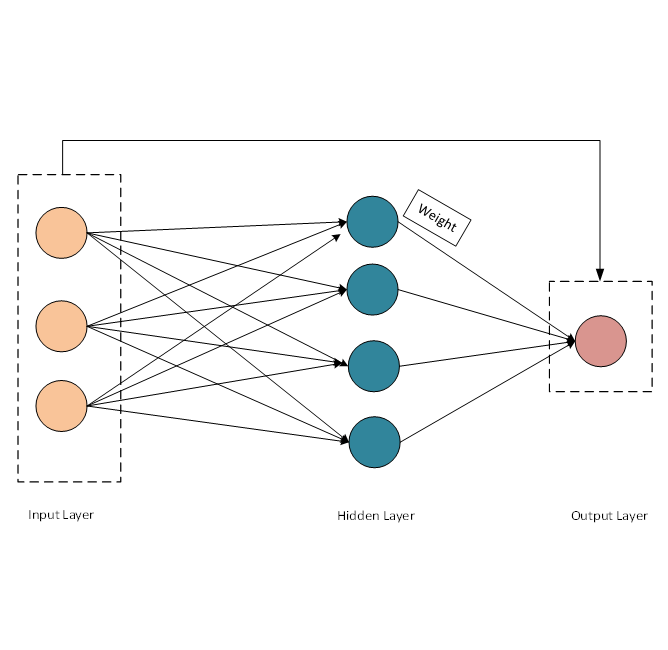Implementation of Neural Networks in Daily PV Power Output Prediction Using Bayesian Regularization Algorithms to Assist Energy Management Systems

Downloads
Solar power plants have several advantages, namely continuous energy production, reduced electricity demand, and low photovoltaic maintenance, so that PV power output can be optimized with reliable PV power output predictions. Implementation of Artificial Neural Network (ANN) to predict photovoltaic (PV) power output, using the Bayesian Regularization algorithm. Accurate PV power output prediction is very important in power systems. The data used are solar radiation, PV module temperature, ambient temperature, and actual PV power output, with the target being the PV power output for the next day with the PV power output output for the next day. The architecture used in this study is a Cascade Forward Neural Network (CFNN) and an Elman Neural Network (ENN). Both ANN models use daily data sets and performance evaluation using Mean Square Error (MSE). The results of the study show that ENN is more accurate than CFNN. ENN had the lowest MSE of 0.00664 at a configuration of N=8 and R of 0.9922 with a training time of 6.4 seconds, while CFNN recorded the lowest MSE of 0.024306 with N=25. ENN's ability to capture time series patterns in PV is more reliable and effective. Reliable predictions can assist in energy management systems because they help maintain supply balance, reduce the risk of failure, and improve system stability.
Downloads
[1] M. A. Atiea, A. A. Abdelghaffar, H. Ben Aribia, F. Noureddine, and A. M. Shaheen, “Photovoltaic power generation forecasting with Bayesian optimization and stacked ensemble learning,” Results Eng., vol. 26, no. April, p. 104950, 2025, doi: 10.1016/j.rineng.2025.104950.
[2] O. Khouili, M. Hanine, M. Louzazni, M. A. L. Flores, E. G. Villena, and I. Ashraf, “Evaluating the impact of deep learning approaches on solar and photovoltaic power forecasting: A systematic review,” Energy Strateg. Rev., vol. 59, no. April, p. 101735, 2025, doi: 10.1016/j.esr.2025.101735.
[3] X. Xiang, X. Li, Y. Zhang, and J. Hu, “A short-term forecasting method for photovoltaic power generation based on the TCN-ECANet-GRU hybrid model,” Sci. Rep., vol. 14, no. 1, pp. 1–12, 2024, doi: 10.1038/s41598-024-56751-6.
[4] X. Z. XinYu Ma, “A short-term prediction model to forecast power of photovoltaic based on MFA-Elman,” Energy Reports, vol. 8, no. 4, 2024, doi: https://doi.org/10.1016/j.egyr.2022.01.213.
[5] V. L. A. Mellit, A. Massi Pavan, “Deep learning neural networks for short-term photovoltaic power forecasting,” Renew. Energy, vol. 172, pp. 276–288, 2021, doi: https://doi.org/10.1016/j.renene.2021.02.16.
[6] Y. L. Ruoyu Liao;, Z. L. Zhengbo Li, and J. L. Yongdong Chen, Xiaodong Shen, “Enhanced photovoltaic power generation forecasting for newly-built plants via Physics-Infused transfer learning with domain adversarial neural networks,” Energy Convers. Manag., vol. 322, 2024, doi: https://doi.org/10.1016/j.enconman.2024.119114.
[7] C. H. Rovianto, Eki, Rezi Delfianti, Bhre Wangsa Lenggana, “Dynamic Optimal Power Flow on Microgrid Incorporating Battery Energy Storage Considering Operational and Maintenance Cost,” Proc. 9th Int. Conf. Exhib. Sustain. Energy Adv. Mater., pp. 65–270, 2024, doi: https://doi.org/10.1007/978-981-97-0106-3_44.
[8] J. L. Yangjun Zhou, Shuhui Pan, Liwen Qin, Zhiyong Yuan, Weixiang Huang, Hao Bai, “Short-term solar power forecasting based on convolutional neural network and analytical knowledge,” Int. Trans. Elekctrical Energy Syst., 2021, doi: https://doi.org/10.1002/2050-7038.13111.
[9] R. Roy, A. J. Varghese, R. Roy, and A. J. Varghese, “PV POWER FORECASTING USING ARTIFICIAL NEURAL NETWORKS,” vol. 21, no. 9, pp. 4999–5007, 2022.
[10] G. Tziolis et al., “Short-term electric net load forecasting for solar-integrated distribution systems based on Bayesian neural networks and statistical post-processing,” Energy, vol. 271, no. August 2022, p. 127018, 2023, doi: 10.1016/j.energy.2023.127018.
[11] R. Delfianti, E. Rovianto, C. Harsito, J. A. Pradana, V. Pongajow, and S. R. Joshua, “Daily Electrical Energy Forecasting in Rooftop Photovoltaic Systems: A Case Study,” J. Soft Comput. Data Min., vol. 5, no. 2, pp. 197–207, 2024, doi: 10.30880/jscdm.2024.05.02.015.
[12] K. B. Hanifulkhair, A. Priyadi, V. Lystianingrum, and R. Delfianti, “One Day Ahead Prediction of PV Power Plant for Energy Management System Using Neural Network,” Proc. - 2020 Int. Semin. Intell. Technol. Its Appl. Humanification Reliab. Intell. Syst. ISITIA 2020, no. September, pp. 107–112, 2020, doi: 10.1109/ISITIA49792.2020.9163783.
[13] M. Rim, B. Ammar, and A. Oualha, “Using Reccurent Neural Networks,” pp. 537–544, 2017.
[14] N. Mahmudah et al., Prediction of PV Power Output and Battery Charging Conditions on OFF Grid Systems MicroHydro Pantai Bantul Yogyakarta Using Rule-Based Algorithm, vol. 2023. Atlantis Press International BV, 2024. doi: 10.2991/978-94-6463-364-1_94.
[15] M. S. Alkhasawneh and L. T. Tay, “A Hybrid Intelligent System Integrating the Cascade Forward Neural Network with Elman Neural Network,” Arab. J. Sci. Eng., vol. 43, no. 12, pp. 6737–6749, 2018, doi: 10.1007/s13369-017-2833-3.
[16] I. A. ,Miguel Angel López Flores Oussama Khouili, Mohamed Haninem, Mohamed Louzazni,duardo García Villena, “Evaluating the impact of deep learning approaches on solar and photovoltaic power forecasting: A systematic review,” Energy Strateg. Rev., vol. 59, 2025, doi: https://doi.org/10.1016/j.esr.2025.101735.
[17] H. Alghamdi et al., “Bayesian neural networks for solar power forecasts in advanced thermoelectric systems,” Case Stud. Therm. Eng., vol. 61, no. August, p. 104940, 2024, doi: 10.1016/j.csite.2024.104940.
[18] A. Altaye, I. Farkas, and P. Víg, “Impacts of Artificial Neural Network Training Algorithms on the Accuracy of PV System Voltage and Current Predictions,” Eur. J. Energy Res., vol. 5, no. 3, pp. 1–6, 2025, doi: 10.24018/ejenergy.2025.5.3.161.
[19] S. E. Awan, M. A. Z. Raja, M. Awais, and C. M. Shu, “Intelligent Bayesian regularization networks for bio-convective nanofluid flow model involving gyro-tactic organisms with viscous dissipation, stratification and heat immersion,” Eng. Appl. Comput. Fluid Mech., vol. 15, no. 1, pp. 1508–1530, 2021, doi: 10.1080/19942060.2021.1974946.
[20] A. Pamain, P. V. Kanaka Rao, and F. N. Tilya, “Prediction of photovoltaic power output based on different non-linear autoregressive artificial neural network algorithms,” Glob. Energy Interconnect., vol. 5, no. 2, pp. 226–235, 2022, doi: 10.1016/j.gloei.2022.04.019.
[21] T. Alquthami, M. A. Magzoub, and A. M. Osman, “A Day Ahead Prediction of Solar PV Power Output Using Ensemble Neural Network,” 22nd Int. Middle East Power Syst. Conf. MEPCON 2021 - Proc., pp. 20–25, 2021, doi: 10.1109/MEPCON50283.2021.9686300.
[22] M. H. Alomari, O. Younisy, and S. M. A. Hayajnehz, “A predictive model for solar photovoltaic power using the Levenberg-Marquardt and Bayesian regularization algorithms and real-time weather data,” Int. J. Adv. Comput. Sci. Appl., vol. 9, no. 1, pp. 347–353, 2018, doi: 10.14569/IJACSA.2018.090148.
[23] H. M. Ridha et al., “A novel prediction of the PV system output current based on integration of optimized hyperparameters of multi-layer neural networks and polynomial regression models,” Next Energy, vol. 8, no. October 2024, p. 100256, 2025, doi: 10.1016/j.nxener.2025.100256.
[24] N. Mahmudah, A. Priyadi, A. L. Setya Budi, and V. L. Budiharto Putri, “Photovoltaic Power Forecasting Using Cascade Forward Neural Network Based on Levenberg-Marquardt Algorithm,” ICPEA 2021 - 2021 IEEE Int. Conf. Power Eng. Appl., no. March, pp. 115–120, 2021, doi: 10.1109/ICPEA51500.2021.9417842.
[25] Q. Lv et al., “Photovoltaic Power Forecasting in Dunhuang based on Recurrent Neural Network,” 2021 IEEE 23rd Int. Conf. High Perform. Comput. Commun. 7th Int. Conf. Data Sci. Syst. 19th Int. Conf. Smart City 7th Int. Conf. Dependability Sensor, Cl, pp. 1346–1352, 2022, doi: 10.1109/HPCC-DSS-SmartCity-DependSys53884.2021.00203.
[26] T. Yang, M. Tang, H. Li, H. Wang, and C. Rao, “A novel PV power prediction method with TCN-Wpsformer model considering data repair and FCM cluster,” Sci. Rep., vol. 15, no. 1, pp. 1–22, 2025, doi: 10.1038/s41598-025-95843-9.
[27] L. O. Lamidi, A. M. Oyelakin, and M. B. Akinbi, “A Survey on Machine Learning Techniques for The Prediction of Solar Power Production,” Indones. J. Data Sci., vol. 5, no. 2, pp. 109–114, 2024, doi: 10.56705/ijodas.v5i2.130.
[28] Z. Zhang, “A gentle introduction to artificial neural networks,” Ann. Transl. Med., vol. 4, no. 19, pp. 1–6, 2016, doi: 10.21037/atm.2016.06.20.
[29] U. Waqas, M. F. Ahmed, H. M. A. Rashid, and M. E. Al-Atroush, “Optimization of neural-network model using a meta-heuristic algorithm for the estimation of dynamic Poisson’s ratio of selected rock types,” Sci. Rep., vol. 13, no. 1, pp. 1–19, 2023, doi: 10.1038/s41598-023-38163-0.
[30] V. Kusuma, A. Privadi, A. L. Setya Budi, and V. L. Budiharto Putri, “Photovoltaic Power Forecasting Using Recurrent Neural Network Based on Bayesian Regularization Algorithm,” ICPEA 2021 - 2021 IEEE Int. Conf. Power Eng. Appl., no. March, pp. 109–114, 2021, doi: 10.1109/ICPEA51500.2021.9417833.

This work is licensed under a Creative Commons Attribution-ShareAlike 4.0 International License.
The Authors submitting a manuscript do so on the understanding that if accepted for publication, copyright publishing of the article shall be assigned to Journal.



















